The Rome of the first half of the 14th century saw the beginning of a “slow and complex revolution,” writes Eloisa Dodero in the catalog of the exhibition Recycling Beauty, the show that the Fondazione Prada in Milan, in the spaces of the Podium and the Cistern, dedicates to the theme of the reuse of Greek and Roman antiquities in different temporal contexts. One can discuss at length the term with which to classify the set of processes that have led to “the rescue and reinterpretation of the artistic testimonies of a disappeared civilization” and whose origins are to be found in a long list of historical, cultural, social, economic, political, ideological and aesthetic reasons: what is certain is that the image of Rome, over the centuries, has also been formed by establishing unprecedented relationships with a past that has been continually reused, reread, reinterpreted, and that for these reasons has been able to survive to the present day. Since at least the 1940s, critics have continued to examine the many aspects of the reuse of materials from the past, a practice that, in post-antique contexts, has been driven by the most diverse needs, although only in recent years has the debate intensified and begun to illuminate a subject of study on which weighed the gloomy blanket of a vulgate for which reuse was to be understood "as brutal spoliation due to the loss of know-how," to use Dodero’s words again. And although there has been no shortage of exhibition occasions in the past that have addressed the theme of antique reuse (albeit mostly as part of reviews on broader topics: comes to mind, just to advance a single example, the major exhibition Aurea Roma organized on the occasion of the Jubilee of 2000, which had a section on the transition from classical to Christian iconographies), the exhibition at the Fondazione Prada represents the first, important review that offers a systematic overview of the many ways the practice took on from late antiquity onward.
The reuse of the past, writes Salvatore Settis, curator of Recycling Beauty along with Anna Anguissola and Denise La Monica, in his catalog essay, “involves the coexistence of different temporalities, where historical distance and narrative and emotional simultaneity are constantly intertwined: therefore, although ancient marbles belong ”to the same cultural horizon as those who reuse them, and therefore appropriating them is felt as natural,“ there is a dimension-time that ”escapes the calendrical sequence; it is unstable, can be manipulated and bent by complicating time, reactivating prestigious ancestors, comparing events from different eras, fabricating memories,“ with the consequence that ”recycling generates meaning“ by creating ”an intertextual or interobjective network, which contains its components but does not coincide with any of them.“ Here then is where reuse, says Settis, is not a subject pertaining to the past, not a subject to be observed with detachment: it speaks, if anything, to the future and speaks of the future. This should be the highest sense of the exhibition, which also has the stated purpose of focusing on the importance of the past for our conception of ”modernity," since some values, some categories, some models survive over the centuries, and often the ancient becomes the key to interpreting the contemporary world and its many different cultures.
The achievement of this twofold objective, which is on the one hand eminently art-historical and on the other hand aims almost at an anthropological reading of the practice of reuse, appears, however, to be hindered, if not thwarted, first and foremost by the setting up of Rem Koolhas and Giulio Margheri, who use the Podium for what it is: a large open space where the visitor is left with the most total freedom of movement, with the consequence of fostering yes a more personal approach towards the material on display, but also with the unfortunate effect of leaving the visitor at the mercy of the equipment conceived by the two architects, also accomplice to the almost total absence (except for an introduction with statements of intent, and a pamphlet with a condensed version of Settis’s essay in the catalog) of illustrative apparatuses that would allow for a framing of the material on display and that would not merely tell the story of the individual objects in brief.

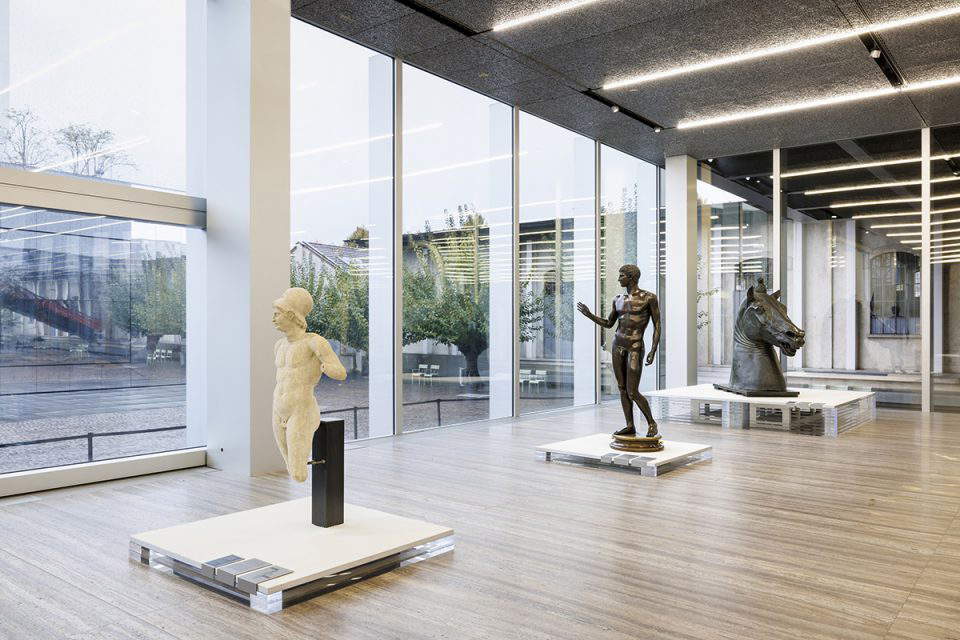
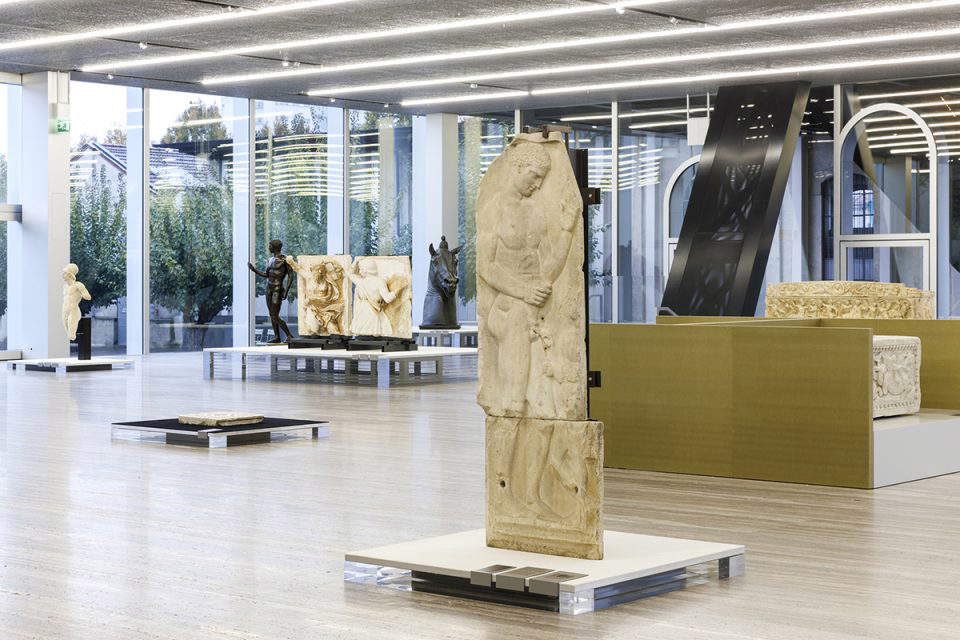
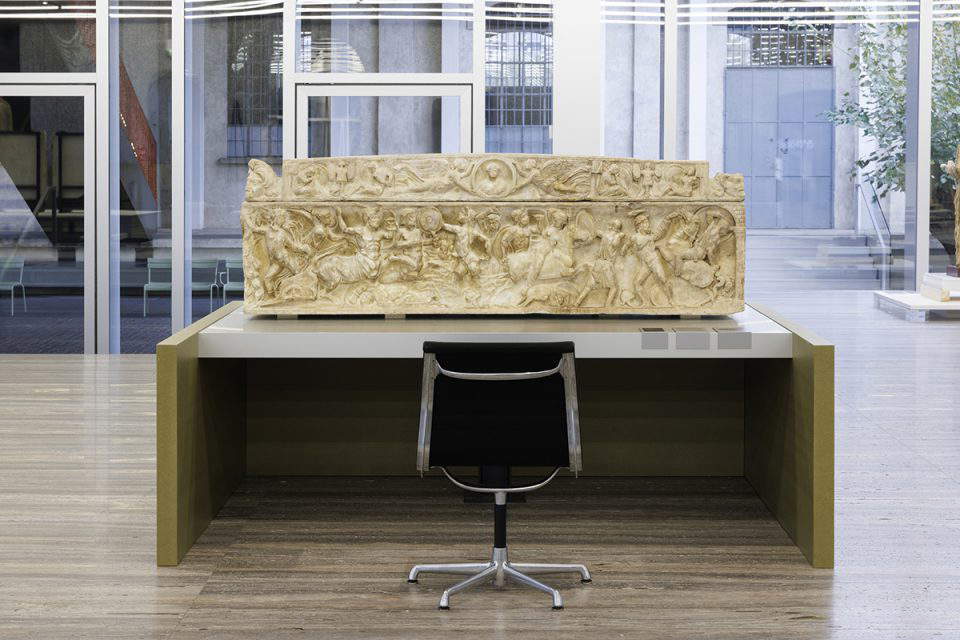

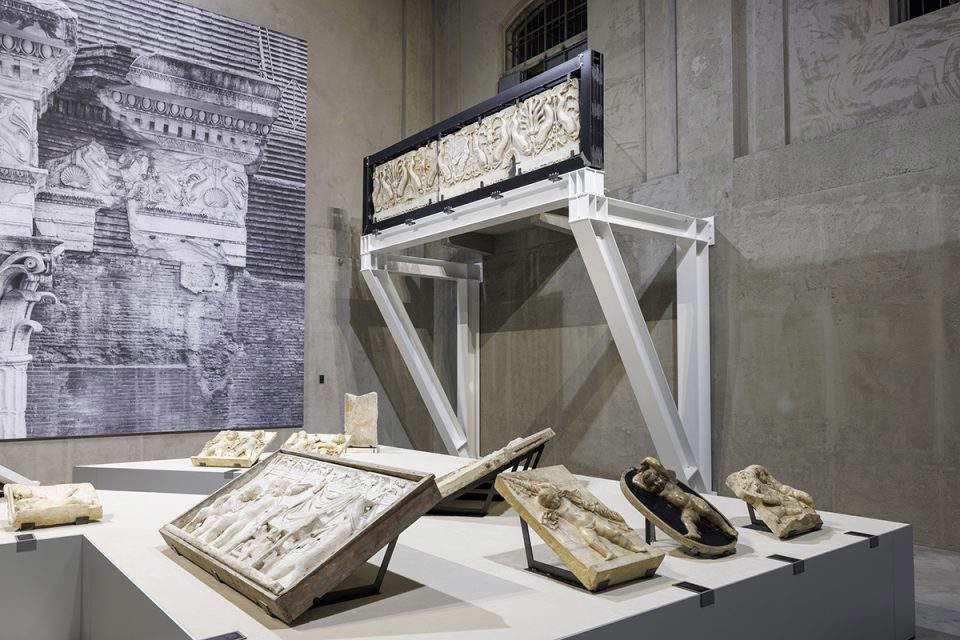
The risks of a set-up such as the one imagined for Recycling Beauty are several: the first, and most obvious, lies in the fact that the exhibition struggles to provide the visitor with a context, a frame, a set of keys to interpretation, and vice versa it ends up lapsing into the anecdotal. The second is the risk of not adequately bringing out the value of the works: take, for example, the works of Nicolas Cordier, one of the high points of the exhibition, since two works, the Gypsy and the Moor, which were once in the collection of Scipione Borghese, were brought together after a long time. They were displayed together with the Camillus that inspired the Moor Borghese, but too close to the wall prevents an overall view. One could then continue with the gimmick of the works displayed above the desks, in an attempt to convey to the visitor the idea of the temporal flow that invests the fragments of the past: it forces one to assume unnatural points of view, and moreover, if someone should entertain the idea of sitting in an office position, with elbows resting on the desk, he will invariably incur the presence of the surveillance officer who will ask him to set his work chair at a proper distance. And then again, one could mention the diptych of Boethius, the back of which was reused by the addition of two miniatures, with the Resurrection of Lazarus and the Fathers of the Church: the arrangement does not allow one to observe the verso of the work, thus precisely the side that attests to the reuse (and it is not the only work that is appreciated with difficulty: just look at the Mensa Isiaca, placed under a shrine that reflects the lights of the ceiling making it impossible to view without disturbance). And then there is the risk of incurring the amusement park effect, notably in the Cistern where the reconstruction of the Colossus of Constantine is exhibited (complete with a small terrace from which visitors look out), where the Farnese Cup is placed in a porthole with a view of the following rooms (and to observe the verso of the cameo, disputed, moreover, with the Gallerie d’Italia because the MANN in Naples arranged, perhaps through an oversight, to lend it to both the Prada Foundation and the museum in Piazza Scala at the same time, one must wait to cross two rooms: an idea out of any logic), where the Ravenna Thrones find space on a long polygonal plinth that does not facilitate the viewing of the works. But the same could also be said of the Podium, which from the outside, when the glass walls are not closed as they were for Domenico Gnoli’s monograph, always gives the appearance of being a large aquarium: it may be interesting for certain contemporary art exhibitions, but it appears out of place for an ambitious review like Recycling Beauty.
Yet, to envision a coherent and clear path would have required little: it would have been interesting, for example, to reintroduce in the exhibition the conceptual dyads on which the essays in the catalog were set (utility versus ostentation, destruction versus interpretation, dispersion versus concentration, form versus meaning, politics versus aesthetics, real versus virtual, practices versus concepts), and which provide a first, very useful tool to familiarize oneself with the theme of reuse. Here, then, we would discover how the gilded bronze peacocks that were once part of Hadrian’s mausoleum (only two survive, one of which is exhibited in Milan) and were later reused to decorate the cantharos Paradisi, the “fountain of Paradise” in front of the old basilica of St. Peter’s, can be considered an example of “ostentatious reuse,” to use the expression that gives title to Giandomenico Spinola’s essay: reused for their allegorical meaning alluding to rebirth, they were deemed “very appropriate,” Spinola explains, “to decorate that fountain that was to welcome and refresh pilgrims in the cradle of Roman Christianity.” The Farnese Cup itself, although displayed in isolation from the rest of the exhibition, responded according to Spinola to similar needs for ostentation, linked in this case to personal propaganda functions, when the precious work was acquired by Frederick II in 1239. If the Farnese Cup is an exceptional case of the survival of a fragile artifact that has remained substantially intact from antiquity to the present day, the remains of the Colossus of Constantine, on the other hand, are the most shining evidence of a case of destruction: the enormous statue, of which the exhibition proposes an idea of reconstruction (significant is the fact that the enormous fetish of plaster, resin and polystyrene attracts the public more than the real remains, the ones that moved Füssli to emotion: in Milan it is possible to admire the hand and foot that came from the Capitoline Museums), was destroyed at an unspecified time. Possibly damaged as early as Late Antiquity, the statue was then probably exploited for perusal material, and its fragments were found in 1486 and brought to the Capitol, in the Palazzo dei Conservatori, because of their importance, which was immediately recognized. The panels in the room merely mention that originally the colossus “perhaps represented an earlier emperor or (more likely) a god,” and the hypothesis is presented that in ancient times the colossus may have been the statue of the Capitol’s Jupiter Optimus Maximus: thus no further detail is given to the possibility, which has also been argued by influential critics, that Constantine had an original statue dedicated to his defeated predecessor, Maxentius, reworked, a hypothesis that would have allowed an introduction to the theme of damnatio memoriae: although the idea of an identification with Maxentius was discarded long ago by Paul Zanker (and on the occasion of Recycling Beauty, Claudio Parisi Presicce returns to the subject to take up Zanker’s point that originally the head was not that of Maxentius but that of a deity, and to revive the hypothesis of the reuse of the statue of Jupiter), the colossus was nevertheless located within a building, the Basilica Nova, begun by Constantine’s rival, and furthermore, Parisi Presicce already wrote in 2006, “the dedication of the colossal statue to the emperor, depicted according to a pagan tradition in heroic transposition of the type of seated Jupiter, can only be attributed to the Senate, perhaps to legitimize his victory over Maxentius.” A victory whose consequence was a damnatio that, although not officially sanctioned, was substantiated in the transmission of a negative memory of Maxentius, since the inscription on the arch of Constantine that calls his opponent a tyrannus.
Moreover, the apparatuses, which list all the surviving pieces of the colossus, fail to mention that the neck is a modern addition: it was carved in Carrara marble (the ancient parts are instead in Parian marble) by Ruggero Bascapè in the late 16th century, when the head of the colossus was placed in the Capitol, at the top of the fountain exhibit built around the statue of Marforio. The exhibition aligns numerous examples of ancient statues integrated in modern times, in some cases in such a way as to arrive at almost entirely new works: this is the case of the aforementioned works by Nicolas Cordier, the Borghese Moor, composed of an ancient head in black marble and other fragments to which the French artist added arms, legs and neck to achieve a completely new statue, just as the Zingarella (whose head is an invention of Cordier’s, on a par with the right hand and feet), which for the first time after its separation from the Moor is reunited with the latter. The possibility of seeing the camillus (a young man assigned to cultic functions) and the Moor together, since Cordier, for his work, was clearly inspired by the statue in the Capitoline Museums, which figures among those donated by Sixtus IV to the people of Rome (the act gave birth to the first nucleus of the museums), constitutes one of the most interesting and most successful moments of the exhibition.
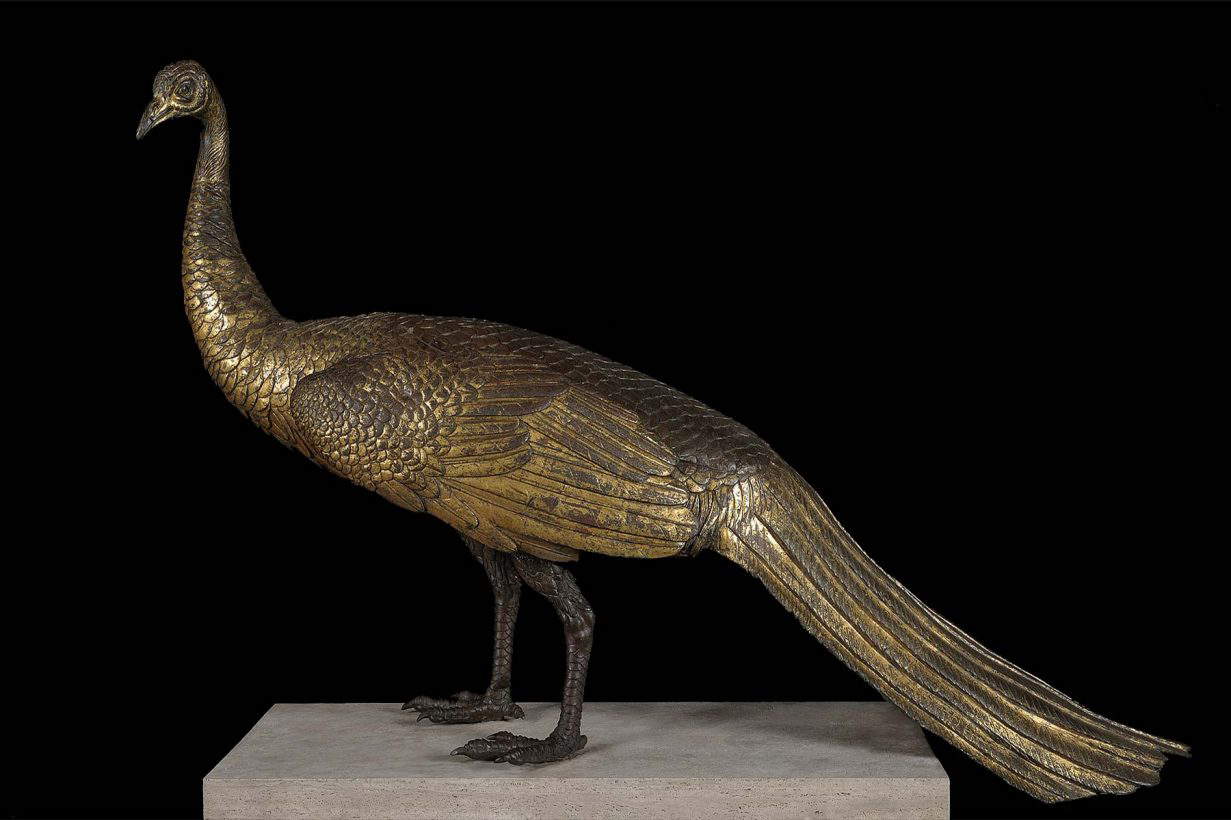




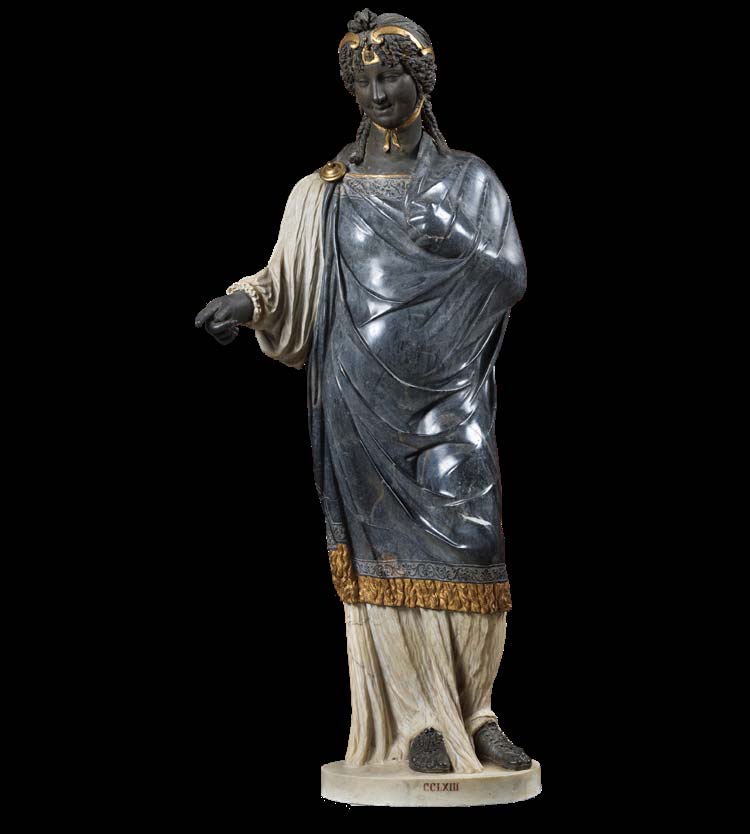
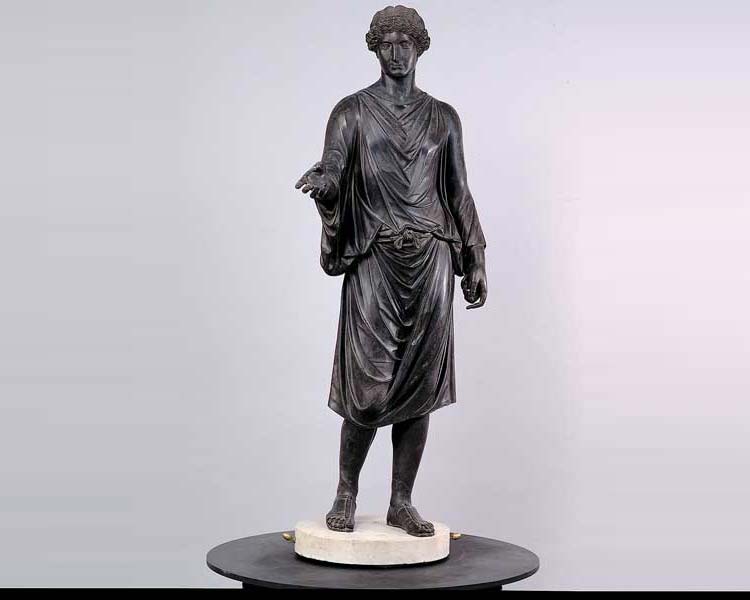
If, as mentioned, the remains of the Colossus are an example of destruction, cases of interpretatio christiana abound in the exhibition, vice versa, a topic addressed in the catalog by Maria Lidova, who cites as examples the ancient sarcophagi that were often preserved and reused by Christian artists, undergoing radical changes in some cases, and in others remained instead substantially intact, providing insights and sources of inspiration. On display, therefore, is the 2nd-century AD sarcophagus, on loan from the Diocesan Museum of Cortona, which depicts a battle of Dionysus, and which in 1247 was reused as the tomb of the blessed Guido Vagnottelli da Cortona (apparently admired by Filippo Brunelleschi, who went to Cortona on purpose to draw it: it was in fact a well-known work in the Renaissance period), and then again an Etruscan urn with the myth of Pelops and Hippodamia, used as a reliquary of the remains of Saint Felix, and finally an interesting oscillum, a marble disk that was hung as a votive gift in Roman times, bearing the scene of the transportation of a wounded soldier, later modified in Christian times with the addition of haloes around the heads of the characters to transform the story into a Deposition of Christ. The dichotomy between form and meaning, on the other hand, is well expressed by some works that, while retaining identical forms from those of the past, have undergone radical changes in meaning, sometimes made evident simply by the addition of a few inscriptions to make them explicit: this is the case with the Santacroce relief, a sculpture with three portraits of the deceased, dating back to the first century B.C., to which the inscriptions “Amor,” “Veritas,” and “Honor” were added in the fifteenth century to transform them into allegories of the virtues of the Santacroce family, which renamed the fragment as “Fidei simulacrum.” Based on the same principle, seven ancient portraits were placed on the façade of Palazzo Trinci in Foligno in the 15th century to symbolize the seven ages of man: they are all on display above a desk. Sometimes the incorporation turned out to be more complex, as evidenced by the statue of Antoninus Pius as Saint Joseph on loan from the Ny Carlsberg Glyptotek in Copenhagen: a portrait of Emperor Antoninus Pius was installed on the body of a priest circa 150-200 A.D., and the statue was then transformed into an effigy of Saint Joseph with the simple addition of a flowering rod (attested in the late 19th century, later dispersed), his iconographic attribute. A further shift in meaning, albeit in a political key, is evidenced by the famous Lion Biting a Horse, a Greek sculpture from the fourth century B.C. that was originally perhaps part of a depiction of Alexander the Great hunting, and in the Middle Ages was placed on the Capitol to symbolize the power of Rome and its good government.
A corner of the Podium has been reserved for a number of modern objects that were, however, mistaken in the past for products of antiquity because of their similarity to Roman-era works. One can start with the Lottatori Aldobrandini, two reliefs depicting the boxing match between the Syracusan Entellus and the Trojan Darete, recounted by Virgil in theAeneid: attested at the Villa Aldobrandini at the Quirinale, they were brought to the Vatican in 1812 and are still on display at the Vatican Museums. They were believed to be ancient until a few years ago (a nineteenth-century hypothesis that they were found in the Forum of Trajan continued to be given credence for a long time), after which they were identified as the work of an unknown sixteenth-century artist. Also believed to be ancient was the sculpture that until 1885 decorated one of the spires of the Milan cathedral and that was lent to the exhibition by the Duomo Museum: on the occasion of Recycling Beauty it was better studied and it was thus possible to demonstrate that it is a modern work in Candoglia marble, a material never used in Roman times. Finally, the section culminates with Donatello’s Protome Carafa, the enormous horse head that the Florentine artist executed in the 1550s in preparation for the creation of an equestrian monument, which was never finished, for Alfonso V of Aragon: already Vasari, in Lives, calls it a sculpture “so beautiful that many believe it to be ancient.” And despite the authoritative testimony, still in the sixteenth century there were those who refuted the Aretine historiographer by continuing to consider Donatello’s work Hellenistic. The practice of stripping to create new artifacts, motivated mostly by economic reasons since it was more practical to exploit by way of quarries the ruins of ancient Rome than to extract new material (Anna Anguissola discusses this topic extensively in her catalog essay), is instead testified to by the cosmatesque slabs of the Cathedral of Anagni, which for some reason are not displayed together but are scattered throughout the Podium: they were made by shattering older works in marble.
The exhibition ends in the Cistern where, in addition to the aforementioned remains of the Colossus, the aforementioned thrones from Ravenna also find their place, which for the first time are brought together in one place, although four of them are present in casts. These are thirteen marble fragments that were most likely part of a single monument that stood in Ravenna, of which they represent all that remains: they are slabs that share the same iconographic theme (which we can appreciate in full from the only intact slab, preserved today in the Louvre), namely an environment within which an empty throne is depicted, covered by a drape, with pairs of winged putti supporting it. Some of the thrones retain the attributes of the deities who were to take possession of them: it is assumed that there were originally twelve thrones, one for each of the Olympian gods. We do not know to what context they belonged: our knowledge of this work from antiquity all postdates its dispersal. “The ’biography’ and geography of each slab,” Chiara Franceschini writes in the catalog, “constitute a chapter of an imaginary book, which has not yet been written.” The exhibition summarizes it with a panel in which the movements of the various fragments are shown to the public. There is, finally, still time for a quick epilogue: one looks up and admires the large frieze with dolphins from the basilica of Neptune in Rome, and later placed in Pisa Cathedral (it was reworked on the back in the 12th century to make an inlaid transenna).
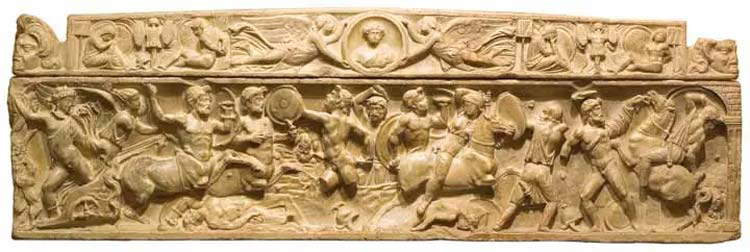
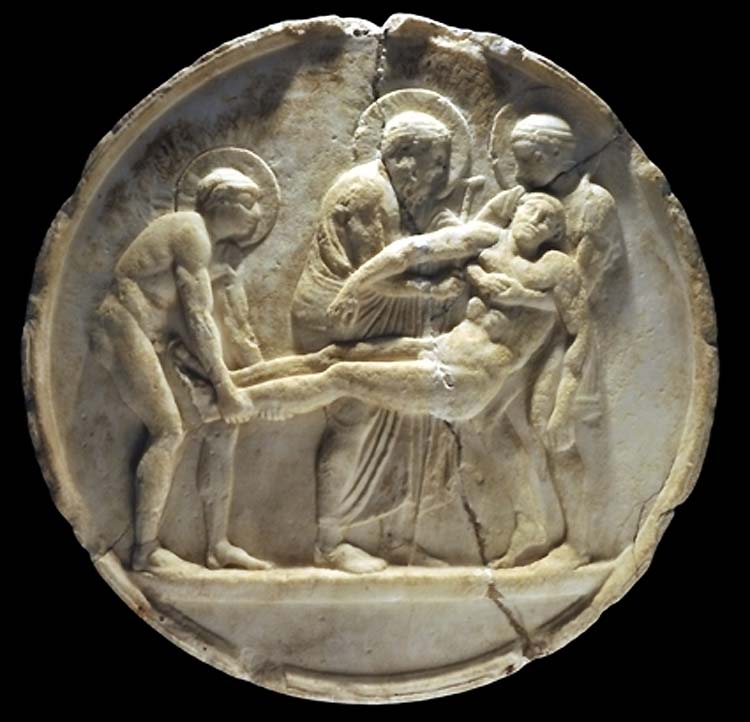

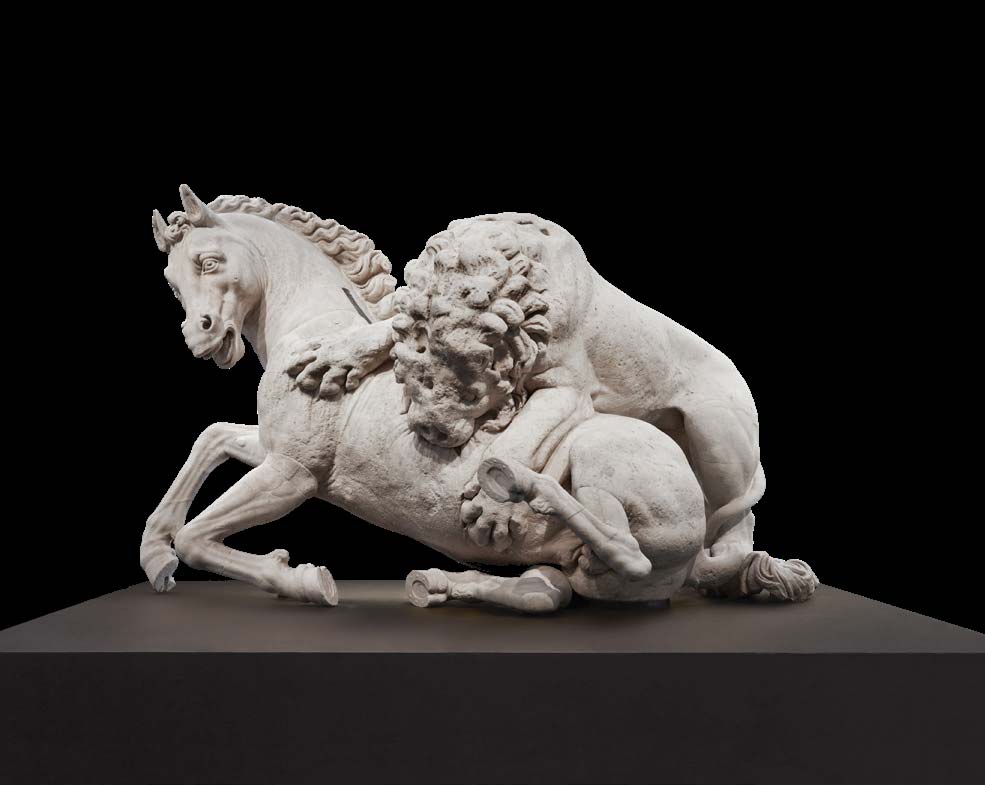
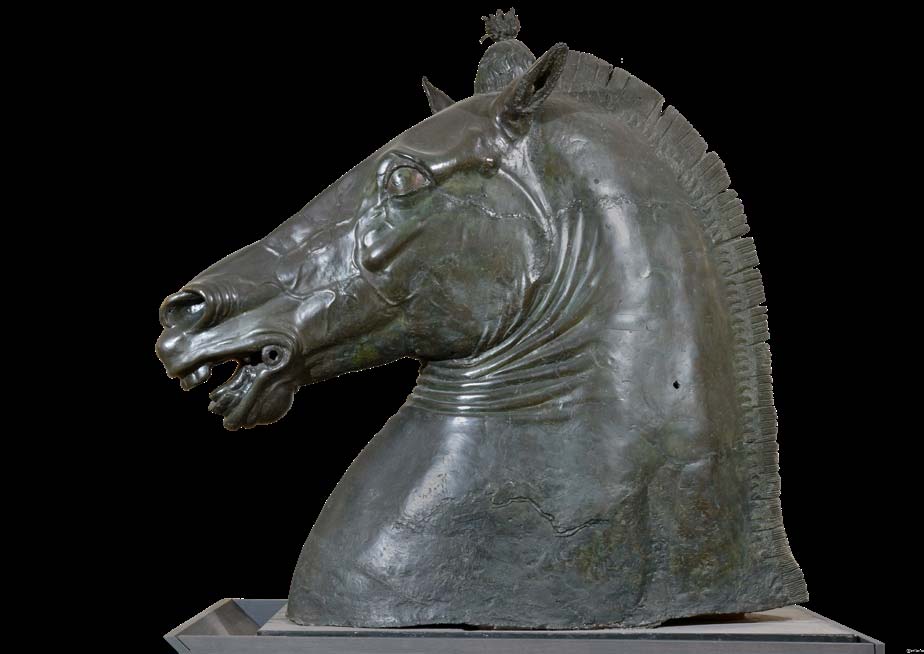
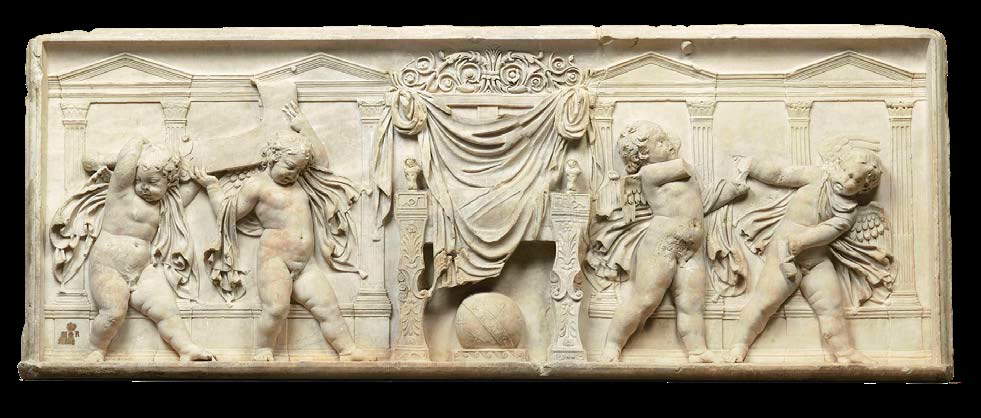
The Fondazione Prada exhibition thus has the same merits and flaws as the most important operation that preceded it, the Domenico Gnoli monograph: as it was on that occasion, Recycling Beauty also presents itself with a significant amount of extraordinary material, of the highest level, but with a layout and apparatuses that do not prove to be up to the level of the pieces on display, do not help to orient oneself among the works, do not invite in-depth study or put the visitor in a position to know something more than the summary events of the individual works on display. In order to get a more complete picture, it is therefore necessary to turn to the catalog, for which other questionable choices have been made, starting with the exorbitant price that is unfortunately typical of Fondazione Prada catalogs (and we are talking about a product that is probably destined, due to its less than exciting typography, to end up as one of the copies left on display for consultation): the volume is in fact available only in English, with Italian versions of only the essays (placed at the conclusion of the volume, with the relative loss of the relationship with the images) and not of the cards, despite the fact that most of the authors are of Italian nationality.
Still, surprising in the negative is the absence of references to the contemporary world, despite the stated premise of wanting to present the classic “not only as a legacy of the past, but as a vital element capable of affecting our present and future.” Of course, it is extremely interesting, useful, and commendable that a luxury brand like Prada has taken the trouble to want to address the issue of reuse and recycling: we are talking about a company that produces consumer-oriented goods, whose industrial processes obviously involve externalities of a certain kind on the environment, and the idea of bringing to everyone’s attention topics that have now become part of our daily lives when it comes to sustainability and respect for the world around us can only be welcomed. A luxury brand talking about recycling, when in the collective imagination luxury is synonymous with waste, squandering, and pollution! It is a momentous stance. However, the problem is that no reasoning, even superficial, on this issue emerges from the exhibition. If anything, the displays offer the same feelings one gets when entering a luxury boutique: a kind of huge window display. It is not enough to note that “the ancients also recycled” to coat Recycling Beauty with a patina of topicality, but one that does not go into depth: what lesson should we contemporaries draw from what we see on display, if it is true that the classic is still a vital element? And why is it a vital element that affects our present and our future? Who in the contemporary world looks at the themes of reuse and recycling to create works, objects, products that are truly able to impact the present and spread new ideas, new thoughts, new arguments? These are questions that remain unanswered.
Finally, an interesting idea should be noted: the flyer distributed at the entrance, the one that contains the summary of Salvatore Settis’ essay, also lists a series of places selected by the curatorial committee “as examples of alteration and conservation of Egyptian, Etruscan, Greek and Roman antiquity on an urban scale.” The places are distributed all over Italy: it is a pity that for Milan the guide only points out the columns of San Lorenzo and the arches of Porta Nuova. It would have been interesting to invite visitors to a more in-depth tour among the reused contexts that are scattered throughout the city, at least the main ones. The altar of St. Celsus, carved from the sarcophagus that contained the saint’s relics. The Carrara marble portal of the 1st-century Chapel of St. Aquilinus, reused from an earlier building. The lapidarium of the Castello Sforzesco, which abounds with similar material. The devil’s column next to the basilica of Sant’Ambrogio, and the same Ottonian ciborium of Sant’Ambrogio with its bare porphyry columns, or the bronze serpent, a singular Hellenistic artifact that tradition says was brought to Milan in 1002 from Constantinople (legend identifies it as the serpent forged by Moses in the desert, and the Milanese attributed thaumaturgic powers to it). The great Roman sarcophagus of Sant’Eustorgio, which according to tradition received the remains of the magi, complete with an 18th-century inscription that turned it into the “sepulcrum trium magorum.” Much also has to tell about the reused ancient works found all over Milan. It’s too bad you leave the Prada Foundation without knowing it.
Warning: the translation into English of the original Italian article was created using automatic tools. We undertake to review all articles, but we do not guarantee the total absence of inaccuracies in the translation due to the program. You can find the original by clicking on the ITA button. If you find any mistake,please contact us.